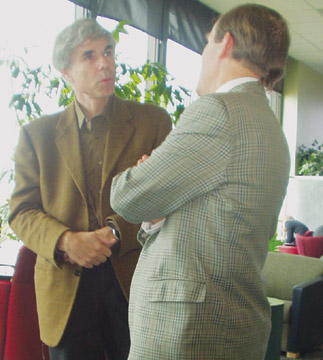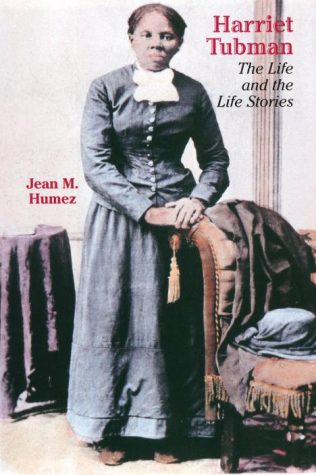Lost in Translation

Douglas Hofstadter waxes philosophical on the finer points of poetry translation to a colleague in the Ryan Lounge. – Photo by MiMi Yeh
November 7, 2003
The average student deals with translated works on a regular basis. Whether it’s Ovid’s Metamorphoses or the works of Hesiod, you end up grabbing a book without paying all that much attention to the translator because you make the assumption that it’s correct. However, for Douglas Hofstadter, Pulitzer Prize winner and author of the book Godel, Escher, Bach: An Eternal Golden Braid, there are always several different meanings that are sometimes lost to translation.
In his lecture, “Translation as a Search for Beauty: The Artistic Blending of Two Cultures,” held in Ryan Lounge on October 29, Hofstadter explained that form and content are integral for capturing the essence of the poem because merely giving a concise and exacting rendition of the poem in the target language is not enough. The accuracy of a translated version depends on word choice, structure, and layout.
Working as a professor of artificial intelligence at Indiana University, Hofstadter has a PhD in Theoretical Condensed Matter and a background in mathematics. His obsession with poetry translations is rooted in a desire to make the literature available to everyone while maintaining the essence of the artist’s work.
Hofstadter began his lecture using an ancient Chinese poem “The Deer Enclosure” as an example of respecting tradition and showing “how to make it acceptable to English expression.” Fluent in Italian and French, he also has a working knowledge of Mandarin Chinese. In ancient times, Chinese was written from right to left and top to bottom. Since there is no use of chronological modifiers, context is everything. Verbs, when translated into English, require conjugation by an adept linguist who is then obligated to make a judgment call in many situations.
Hofstadter then went on to explain that translation was also affected by politics and gender. His work on sexism and the feminist perspective led him to explain how he “is turned off by using the ‘masculine default.'” Hofstadter, in examining the choices made in his version of “The Deer Enclosure,” tried to exemplify what he feels are important principles for dealing with that particular poetic translation: word choice and word count as well as the mono-syllabism that mirrors the rhythms of the Chinese language. With each successive adjustment, the audience was shown just how dramatically the connotations could change when a different element was emphasized.
While describing and giving examples of interesting and terrible editions, he went on to explain that, “there is no optimal way to read a poem. You want something that gives the flavor and same basic feel of the original tone, form, and charm.” For example, in Dante’s Divine Comedy each canto has rhymes occurring in triplets in each tercet, an Italian poetic innovation that involves rhyming two sets of three lines that make up the last part of a sonnet. In this translation, a different poet was required to only do one version of each canto.
Hofstadter also introduced his novel Le Ton Beau de Marot, whose name means literally “The Beautiful Tone of Marot” or “Marot’s Sweet Voice,” perhaps. The name leads back to a poem he fell in love with and memorized when he was 16 before using it as the basis for an explanation of the finer points of translation. One would assume that spewing out a series of permutations on the same piece is mind-numbing work; however, Hofstadter manages to keep it light-hearted with a peculiar mix of commentary, technical expertise, and humor. This is where his background in cognitive science and philosophy come in. He combines the analytical approach of a scientist with an artist’s eye on its outcome.






















































